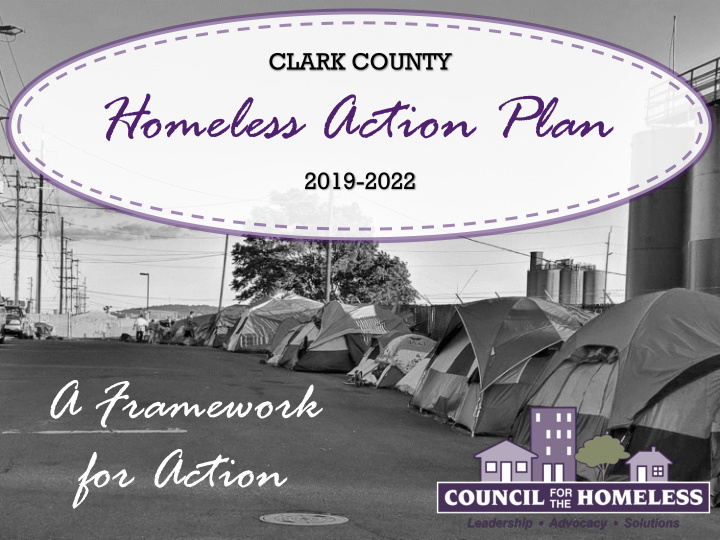



CLARK COUNTY Homeless Action Plan 2019-2022 A Framework for Action
Homeless Action Plan Purpose Charting a Collective Path Forward Identify System and Funding Priorities Achieve Outcomes State Requirement
Community Engagement Community Shelter Electronic Forums Forums Surveys Series of Forums (7 Community Forums & 8 Shelter Forums) Electronic Surveys (806 Responses) 111 Service Providers, 653 Community Members, 42 Individuals Experiencing • Homelessness Data Analysis & Interpretation (Clark County Public Health) Plan Structure Best Practice Approaches • Clear Outcomes • Clear Next Steps •
“I want to live in a community that he help lps s peo eopl ple e who ho ar are e homeless move into housing”
Key Elements of an Effective Homeless Crisis Response System Planning and Data Performance Measures Access and Prioritization • Outreach & Engagement *N o t L i n e a r • Coordinated Entry/Assessment • Diversion Crisis and Interim Housing • Immediate, Easily Accessible and Available for those with High Needs Assistance to Return to Housing • Rapid Re-housing • Permanent Supportive Housing/Supportive Housing
Core Elements of the Plan Homeless Crisis Response System at the Center Expands Capacity Across System Utilized Best Practices and Program Success Encompasses Continuous Improvement Encourages Data Sharing Continues System Integration Expands Partnerships Highlights Policy Recommendations Promotes Client Voice and Lived Experience
Clark County Homeless Strategy Guiding Principles: Outside Policy Recommendations: Priority Populations: Employment • • Affordable Housing Change Tenant & Landlord Rules • • Support for Seniors and people who are Chronically Homeless through DSHS et al. Basic Need Priority: Incentivize creative housing solutions • • Formalize System of Care Connections Decriminalize Homelessness •
System Challenge 2017 Data 2,593 Unduplicated Households Seeking Shelter and/or Housing 2,077 Households 40% of Households Rent Assistance & Supportive 2,459 Households Crisis & Interim Services Housing • Permanent Supportive Housing Housing • Rapid Re- Housing • TBRA 10% of • Diversion Households
A Framework For Change Place and stabilize households in housing through the least intensive supports. Focus on most vulnerable. Stabilize households in Intentionally engage housing by genuinely with those without connecting them to safety net homes to understand resources, so they do not barriers and goals. become homeless again.
Results Increase Mobile Outreach by 8 People and Expand Scope • • Increase the number of shelter beds by 50 Increase motel vouchers: DV survivors & Bridge Housing • Severe Weather Shelter Beds • Increase Access to Fulfill Basic Needs Across County (Bathrooms, • Showers, Laundry & Storage) • Increase Transitional Housing for Youth and DV Survivors Increase all best practice permanent housing (250 spaces) • • 1 Shelter Bed: 5 Permanent Housing Beds Engage Expertise and Voice of people with Lived Experience • Continual Community and Provider Educational Opportunities • • Leverage Resources to Progress Plan Outcomes.
Average Length of Stay/Length of Homelessness % Exits to Permanent Housing Returns to Shelter/Homelessness (Re-user Rate)
Responding with Action (2019-2022) Target families, veterans, youth (12-24), and households who are chronically homeless. Increase programs that serve these populations. Decrease the number of households who are chronically homeless by: Increase number of housing first supportive housing programs and units Work collaboratively with other systems of care (Medicaid Waiver=Supportive Housing) Increase the number of Rapid Re-Housing spots available. Increase the number of Diversion spots and expand population focus. Reduce the number of days households are homeless after entering housing program.
Performance Measurements HUD / WA State Department of Commerce 2017 Outcomes Performance Measurements Average Length of Time Homeless 48 Days Exits to Permanent Housing • Rapid Re-Housing 82% • Transitional Housing 47% • Emergency Shelter 27% Returns to Homelessness (Re-user Rate) 16% • Among all Program Types Unsheltered Entries into all Program Types 70%
Responding with Action (2019-2022) TARGET STRATEGY OUTCOME ACCOUNTABILITY TIMELINE Examine opportunities with local Flexible Funding household support is funding to expand flexibility in incorporated into housing program County/COV System End 2019 & paying for services that respond to reimbursement/guidelines. Alignment Annual community, stakeholder and population input listed in this survey. All HCRS funders require programs to follow a coordinated and system approach. Increase the number of outreach and engagement staff and programs Increase safe park parking spaces Expand scope of outreach and focus on housing for those on the street. Expand the access to basic need (showers, restrooms, storage, laundry, vaccines) Increase low-barrier emergency and severe weather shelter capacity and coordination
Responding with Action (2019-2022) Target families, veterans, youth (12-24), and households who are chronically homeless. Increase programs that serve these populations. Decrease the number of households who are chronically homeless by: Increase number of housing first supportive housing programs and units Work collaboratively with other systems of care (Medicaid Waiver=Supportive Housing) Increase the number of Rapid Re-Housing spots available. Increase the number of Diversion spots and expand population focus. Reduce the number of days households are homeless after entering housing program.
Responding with Action (2019-2022) Create ongoing educational series and staff training. Expand policy focus and advocacy efforts on homelessness. Policy Recommendations Section Invest in predictive prevention (Outside COV) and homelessness diversion strategies locally Provide short-term education and life-skills trainings to support people stabilizing in housing. Increase landlord education and partnerships. Learn from and more formally engage the expertise of people with lived homelessness experience. Create a more culturally aware, trauma-informed, low barrier system.
Activity Page 1 Identify, Assist or Resolve Strengths & Agreements? Page 2 Identify, Assist or Resolve What should be adjusted/changed? Page 3 Policy Recommendations Strengths & Agreements What’s missing?
2 1
3 5 4
Next Steps: Review Plan http://www.councilforthehomeless.org/ homeless-action-plan/ Feedback Period: 9/4/18-9/17/18 hapfeedback@councilforthehomeless.org Community Presentations City of Vancouver Presentation Vancouver Housing Authority Commission Presentation County Council Approval-October Community Education Sessions & New Workgroups- 2019
Thank You
Recommend
More recommend